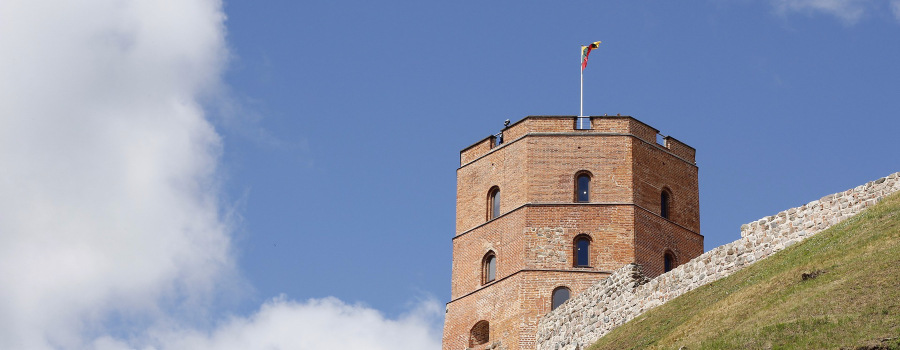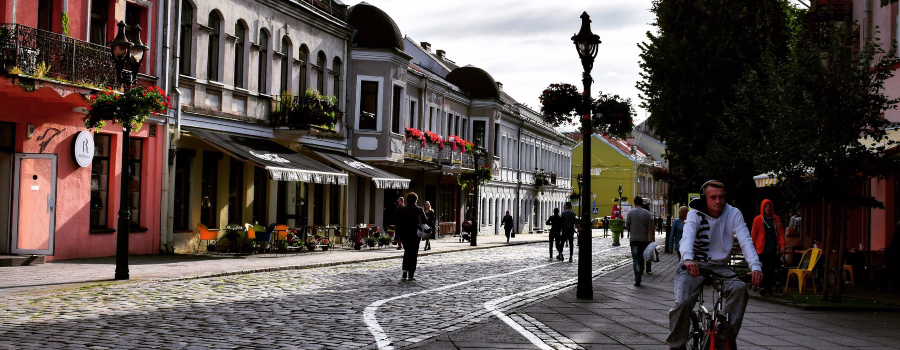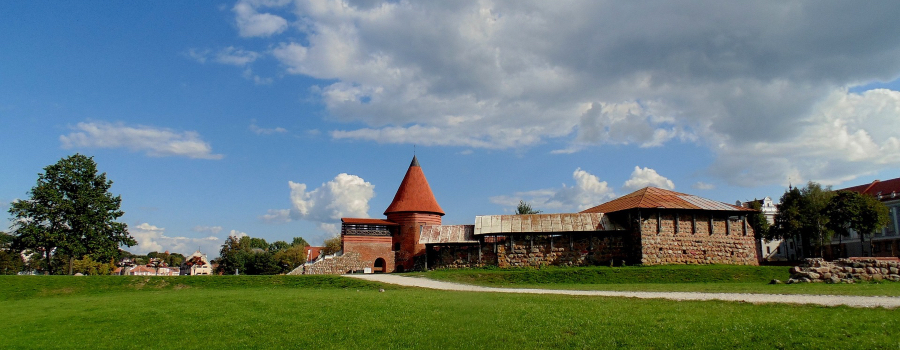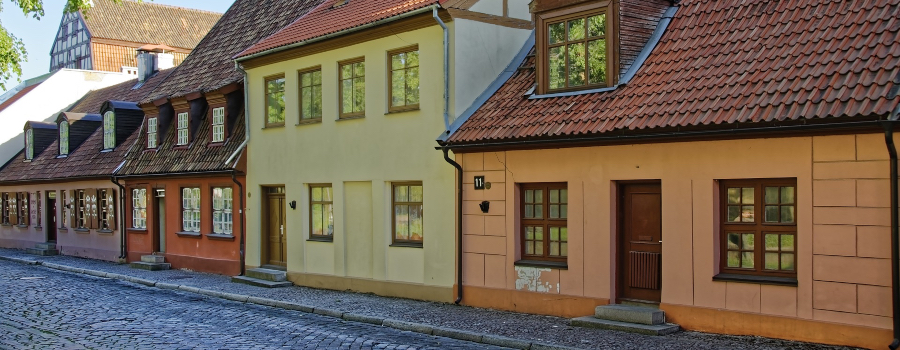Manage my booking
THE TRAVEL BLOG OF BALTIC TOURS

Best Places to Visit in Lithuania
Cities and resorts of the Baltic States differ drastically from their neighbors in Eastern Europe by the number of architectural monuments, historical sites, cultural heritage, and European tidiness. This time, we would like to explore Lithuania, a country in the Baltics, which attracts lots of tourists each year, with numerous castles and dungeons, extremely heavy but delightful cuisine, and amazing nature. We tried to collect all the best places to visit in Lithuania.
Very nice budget-friendly places to visit if you're not afraid of heights
The Hill of Three Crosses: Three tall concrete crosses on a rocky hill above Vilnius are evidence of a long-standing tragedy after Lithuania converted to Christianity at the turn of the 14th century. Missionaries entered the country, and the Vilno voivode Gashtold sheltered several Franciscans at home while he himself departed for war. The pagans, however, were not going to surrender; they seized the monks and executed them, crucifying three on Bald Mountain near the Curve Castle. Later, in memory of the martyrs, they placed three wooden crosses there; in 1916, they were replaced with concrete ones, and after World War II, they were blown up. The current monument was restored in 1989 and is a true replica of the old one. The hill was renamed the Hill of Three Crosses and declared a monument to the victims of Stalinism. At the top, there is an observation platform where a long staircase leads. From here, there is a wonderful view of Vilnius Old Town, the Gediminas Tower, and the Vilna River. In the evening, the lights turn on, and three white crosses seem to hover over the capital of Lithuania. Gediminas Tower is not only the hallmark of Vilnius but also a symbol of Lithuania. Therefore, this magnificent building is depicted in the greater half of the souvenirs. You should definitely visit the tower because from its top, from a height of 70 meters, there opens a breathtaking view of the old part of the city, the picturesque Vilnele River, and also the new Vilnius with its European novelty. Here at the top, the air is filled with freshness; the crooked streets below with the houses under the tiled roofs seem to be an illustration from a good old fairy tale.
Gediminas Tower is not only the hallmark of Vilnius but also a symbol of Lithuania. Therefore, this magnificent building is depicted in the greater half of the souvenirs. You should definitely visit the tower because from its top, from a height of 70 meters, there opens a breathtaking view of the old part of the city, the picturesque Vilnele River, and also the new Vilnius with its European novelty. Here at the top, the air is filled with freshness; the crooked streets below with the houses under the tiled roofs seem to be an illustration from a good old fairy tale.
If you wonder where to go on holiday to Lithuania with your family and kids
Kaunas has many picturesque parks. You should definitely go for a walk in the park Aleksotas Hill. It is located on the top of a hill, and from the natural observation deck of the park opens a panoramic view of the city. You can climb to the top of the hill on the funicular. In addition to equipped seating areas in the park, you can see many interesting sculptures and landscape decorations, as well as historical attractions. There are many benches in the park and equipped picnic areas, and many more spacious lawns where you can play with the children. If your kids and you love nature, Kaunas Botanical Garden is a good place to go to. The most interesting thing to walk in it is in spring and summer when the garden is decorated with thousands of flowering plants. The park has a beautiful lake in which swans live, and there are several beautiful historic buildings on its territory. The garden is quite large, and a walk in it can turn into an unforgettable adventure. You can definitely add this place to your 10 best places to visit in Lithuania. Among the museums that are most interesting to visit with children, it is worth noting Kaunas Zoological Museum of Tadas Ivanauskas. This natural science museum contains an interesting collection of exhibits, in one way or another connected with the natural world. Here you can see collections of butterflies and insects, as well as unique archaeological finds and skeletons of ancient animals that inhabited the planet millions of years ago.
Here are some cool places to go to Lithuania in summer:
Insectarium: This is the only specialized arthropods zoo in Palanga, Lithuania. In this unique zoological garden, up to 100 species of arthropods are exhibited. In the insectarium, you can see live tarantulas, beetles, scorpions, stick insects, praying mantis, cockroaches, and centipedes. Specialists of the zoological garden will acquaint you with the pets and provide advice to those who wish to keep them. Moreover, here you can purchase an exotic animal you like. Such entertainment will be interesting to children of middle and high school age, as well as adults because even many of us are not familiar with the kingdom of arthropods. Duke Tishkevich Alley: Around the Tyszkiewicz Palace in Palanga is a huge botanical park. It was founded in 1897 by order of Count Felix Tyshkevich. Today it is a great place for walking, eco-tourism, and aesthetic pleasure. On an area of more than 860 thousand square meters, there grow about 600 species of representatives of the flora, 24 of which are listed in the Red Book. The park is decorated with sculptures, open glades are replaced by a dense forest, ducks and swans swim in the ponds. Here, every little thing is thought out and designed by the French landscape architect Edouard Andre and is supported by modern specialists. The park is comfortable and calm at any time of the year; there is a beautiful view from everywhere. In the evening, the bushes are highlighted, creating an atmosphere of romance and mystery. Numerous footpaths lead to the sea. The beach near the garden is considered to be one of the best in Palanga. The environment of the park and its unifying element is the mighty pine forest. The botanical garden smoothly flows from three sides into it. In the north, there are city gates, restored according to original drawings after they were destroyed during World War II. Pajūrio Regional Park: The area of the Seaside Regional Park is 5700 ha (2700 ha on land and 3000 ha in the sea). The park is home to the following natural treasures: the seaside coastal dune bar, the Great (24 years old, called the Dutch hake) and the small seaside cliffs, the cliffs, the distinctive seaborne vegetation and wildlife, and the local lakes, Kalotė and Plocias. The sea coast between Karklė and Palanga, the seaside dunes and prayer are included in the Natura 2000 network of protected areas of the EU. The protected cultural heritage values of the park: the only surviving ship rescue station in Nemiresti, the old Karklė and Kalotė school buildings, the closest sea-side Karklė cemetery, the former Karklė Evangelical Lutheran Church building site, the defensive fortifications of the Second World War in the Kukuliškės village - a coastal artillery battery. Dutchman’s Cap: As the glacier retreated on the Lithuanian seacoast, it also formed a unique moraine gutter called the Dutchman’s Cap. This mountain (24.4 m above the sea, a parabolic set) is constantly eroding the waves of mourning and reaching the seaside at a height of 16-18 m. It is believed that the mountain received the name of the "Dutchman’s Cap" because of its similarity to the Dutch cap when viewed from the sea. The Dutch cap has long been a landmark for sailors and fishermen since overgrown with pine trees and oaks, it is well distinguished in the sandy plain. The sea-view offers stunning beaches and stony beaches. It's easy to watch birds flying over the sea. The Dutchman’s Cap is included in the list of natural heritage sites.
Main Bridge of Palanga: It is a place where all roads and streets of Palanga lead, a place where people meet and break up, a place where everything happens, and nothing is left without being noticed. From the main bridge of Palanga opens an amazing view to the Baltic Sea, and there, far away, you can see the white sails piercing the horizon.
Liberty Avenue of Kaunas is the main pedestrian street with a length of 1,621 meters, which connects the old and the new part of Kaunas. Numerous cozy cafes, shops, bakeries, and restaurants are situated along Liberty Avenue.
Oak Grove (Ąžuolynas) is an oak park located in Kaunas, not far from the Church of St. Michael the Archangel, at the very beginning of the Liberty Avenue. This is a wonderful and the largest oak urban park in Europe; some of the trees are over 300 years old. No wonder this park is one of the most favorite vacation spots of the residents and guests of the city. In addition to the oaks in the park, you can find other trees there too, but only deciduous ones: lindens, maples, birches, chestnuts.
To the south of the old town, or rather in its extreme part, not far from the Kaunas castle there are several wonderful places for walks - the embankment of the Neman River such as Santakos Park. While walking in the park of Santakos, you will certainly reach the embankment of the Neman River.
Dutchman’s Cap: As the glacier retreated on the Lithuanian seacoast, it also formed a unique moraine gutter called the Dutchman’s Cap. This mountain (24.4 m above the sea, a parabolic set) is constantly eroding the waves of mourning and reaching the seaside at a height of 16-18 m. It is believed that the mountain received the name of the "Dutchman’s Cap" because of its similarity to the Dutch cap when viewed from the sea. The Dutch cap has long been a landmark for sailors and fishermen since overgrown with pine trees and oaks, it is well distinguished in the sandy plain. The sea-view offers stunning beaches and stony beaches. It's easy to watch birds flying over the sea. The Dutchman’s Cap is included in the list of natural heritage sites.
Main Bridge of Palanga: It is a place where all roads and streets of Palanga lead, a place where people meet and break up, a place where everything happens, and nothing is left without being noticed. From the main bridge of Palanga opens an amazing view to the Baltic Sea, and there, far away, you can see the white sails piercing the horizon.
Liberty Avenue of Kaunas is the main pedestrian street with a length of 1,621 meters, which connects the old and the new part of Kaunas. Numerous cozy cafes, shops, bakeries, and restaurants are situated along Liberty Avenue.
Oak Grove (Ąžuolynas) is an oak park located in Kaunas, not far from the Church of St. Michael the Archangel, at the very beginning of the Liberty Avenue. This is a wonderful and the largest oak urban park in Europe; some of the trees are over 300 years old. No wonder this park is one of the most favorite vacation spots of the residents and guests of the city. In addition to the oaks in the park, you can find other trees there too, but only deciduous ones: lindens, maples, birches, chestnuts.
To the south of the old town, or rather in its extreme part, not far from the Kaunas castle there are several wonderful places for walks - the embankment of the Neman River such as Santakos Park. While walking in the park of Santakos, you will certainly reach the embankment of the Neman River.

If you come to Lithuania in autumn, here are some great places to visit in Vilnius
Pūčkoriai: Lithuania is a country of valleys and hills; there are no mountains, even rocks. However, there is one place that differs from others, with its cliffs and hills looking like real mountains. The hill of Pūčkoriai is a geological monument, situated on the right bank of Vilnia, and it was formed by the side erosion of this river. From the outskirts, there is an amazing panorama of Vilnius surroundings: the waves of the Vilnia River, the hills and forests of the Pavilniai Regional Park, the Pūčkoriai Manor, and the former foundry of cannons. A little further, there are the remains of the old dam of the Belmont Mill. The well-stocked Pūčkoriai Exposure Track is open with wide stairs, wooden paths, terraces, tables. Trakai: It is a beautiful small town surrounded by a lake, which has a charming castle on the island of this lake. The Medieval Trakai Castle has become the “tourist brand” of Lithuania, known far beyond its borders. Moreover, due to its proximity to the capital, a visit to Trakai is a great opportunity to escape from Vilnius landscapes and go on an exciting excursion. Užupis: It is not just a small bohemian quarter, somewhat reminiscent of Paris Montmartre. It is also an independent state, a republic, located in the very center of the capital of another republic, having its own constitution, the president, and even an army. So being in Vilnius, you should definitely visit this distinctive state. On the borders of the district, there are signs indicating that you are entering the territory of the Republic of Užupis. True, the border control here is valid only once a year - April 1, when the Independence Day of the Republic is celebrated. On this day, the “frontier guards” dressed in funny costumes check passports, and on the main square of the district, at the sculpture of an angel, solemn festivities and even a parade of the Užupis army are held. The sights of the quarter include such architectural monuments as, for example, a beautiful specimen of classicism - the Palace of Gonestov, built in the late eighteenth century, and later restored in the early nineteenth century. In Užupis, you will also find many various galleries, clubs, literary cafes, and you will be able to listen to music and attend performances, often held in the open air.Some good places to visit in Lithuania in winter in Kaunas
St. Michael the Archangel: This church of the Roman Catholic Church was built in 1895, and today it is decorated with the majestic walls of the Independence Square of the New City. Devil Museum in Kaunas: If you were sent to hell, immediately go to Kaunas. It is there that is the only Devil Museum in the world. In it, you understand how seductive the devil's world is because all pleasures are somehow connected with the devil. The exposition of the museum can be described in one phrase - a damn interesting place! This entertaining museum houses a huge collection of devils from all over the world - wooden and ceramic, metal and ragged ones. Kaunas Castle is one of those attractions that is a pity to miss: it is perhaps the most famous place in the city. The territory of Kaunas was located in the west of the Lithuanian state and was adjacent to the lands of the Teutonic Order. Crusaders often tried to occupy the Lithuanian lands. To protect them, Lithuanians built Kaunas Castle - the oldest stone castle in Lithuania. The castle was built in the 13th century and is the first defensive bastion in Lithuania and the only fortress that had a double defensive wall made of boulders and separate bricks. Kaunas castle today is a medieval building in the form of a round tower and a wall lined with red brick, which has been preserved to our days.If you like to explore the monuments of the past
The previously mentioned Pūčkoriai Hill: The fact that the hills in the park are great for skiing was noticed before the Second World War. It was the Germans who were the first to equip several ski lifts in these places. The Poles at the time used local relief for military purposes. They built many objects of the so-called defense ring. In Pavilniai Regional Park, there are not a few of them.If you admire dungeons and castles
There is Medininkai Castle in Vilnius outskirts, 2 km from the Belarussian border. Medininkai Castle was opened after restoration in 2012. The exact date of its foundation is unknown. It is believed that it was built by Duke Gediminas, but the first mention of the castle dates back to 1387 - this is the year of the baptism of Lithuania. It was the largest fortress due to its strategic location and extensive defensive structures. The five floors of the exhibition narrate the history of the castle and Lithuania. The exposition showcases weapons, dishes, and various artifacts, providing an interesting glimpse into the past. Additionally, from the central tower of the castle, you can access the observation deck, but this is only available in summer. During winter, access to the observation deck is restricted for security reasons.Top 5 places to visit in Lithuania, if you want to taste real Lithuanian food and drinks
First of all, Avilys is one of the most famous and popular restaurants in Kaunas, located in the building of the old brewery. Today, it is renowned for producing the best beer in the city. In this beautiful and cozy restaurant, visitors can not only enjoy the best types of beer but also savor unique culinary creations. The best Lithuanian fish restaurant is situated in Cape Ventė, a small peninsula on the east coast of the Curonian Lagoon in Klaipėda. The cape, associated with fishing, was the main source of profit in the delta and the Neman sleeves. The freshest fish from local fishermen is prepared in the most sophisticated way. Waves, fishing boats, lighthouses, and the aroma of fish soup – all of this you can experience in Cape Ventė. If you can't make it to the bay, be sure to visit the Vilnius branch of this restaurant, located in Užupis. The interior of the restaurant creates an impression of simplicity, coziness, and originality. It avoids unnecessary elements, allowing guests to focus on the unique taste of the dishes, the warmth of the burning fire, and the tranquility of the surroundings. This is the only fish restaurant in Lithuania where you won't find a traditional menu. Every day, fishermen go to the lagoon, and your meal depends on their success. Each day's catch is displayed on ice, and you can choose which fish you would like to have prepared for you. For the best gastronomic experience in the city, head to Monai, a homely restaurant in Klaipėda. Suitable for both a family dinner and a business lunch. If you come to Trakai, don’t forget to try local pies, which are called kibinai. The best ones are in Senoji Kibininė.If you come to the Lithuanian seaside and wonder what to do in Klaipėda
The Curonian Spit is the place that you should include in your travel guide. It is a unique natural landmark, a 98 km-long strip of sand that separates the Baltic Sea from the Curonian Lagoon. Half of the spit belongs to the Russian Federation, and the second half belongs to Lithuania. Despite its small size, Klaipėda Old Town is extremely beautiful. Take a stroll along the main streets and enjoy the view of local souvenir shops, the seaside air, and the amazing sculptures created by different artists, represented on the main Klaipėda square. Don’t forget to take a picture of the Sculpture of Ghost on the main seafront. Also, seeing sand dunes in Nida, with a view of the Kaliningrad region, Death Valley, and the lighthouse is highly recommended if you come to the Lithuanian seaside in summer. This was a very brief guide on where to travel in Lithuania. Despite the small size of this country, it can always amaze you. If you look at the map of the most interesting and amazing places in Lithuania worth visiting, you will see a lot of them. Some are located around big cities, some in small villages. But you can always find your personal best places to visit in Lithuania.

Professionally educated and highly experienced in tourism management, Rasa is passionate about encouraging guests to explore the Northeastern region of Europe in the most attractive way. She has been working in the tourism industry since 2000, assisting customers from 64 countries, and she loves doing it!


